The AMD Trinity Review (A10-4600M): A New Hope
by Jarred Walton on May 15, 2012 12:00 AM ESTAMD Trinity Gaming Performance
After the 3DMark results, you might be wondering if Intel has finally caught up to AMD in terms of integrated graphics performance. The answer is…yes and no. Depending on the game, there are times where a fast Ivy Bridge CPU with HD 4000 will actually beat out Trinity; there are also times where Intel’s IGP really struggles to keep pace. The good news is that at least everyone is now onboard the DX11 bandwagon, and compatibility with games has improved yet again for Intel. Here are our “Value” benchmark results for seven recent games; we’ll have more information in a moment.

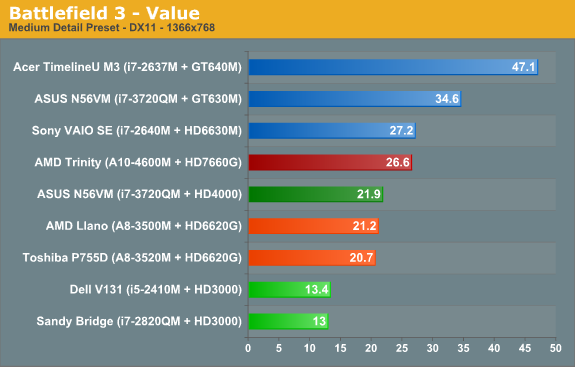
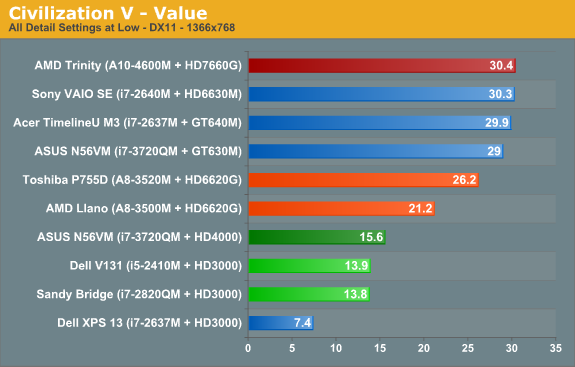

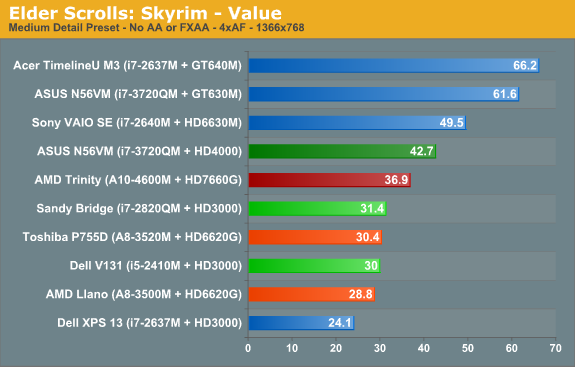
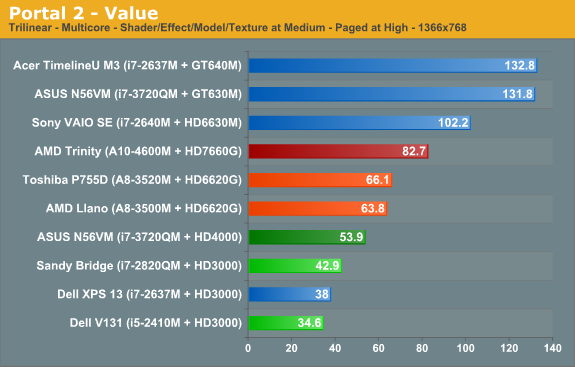
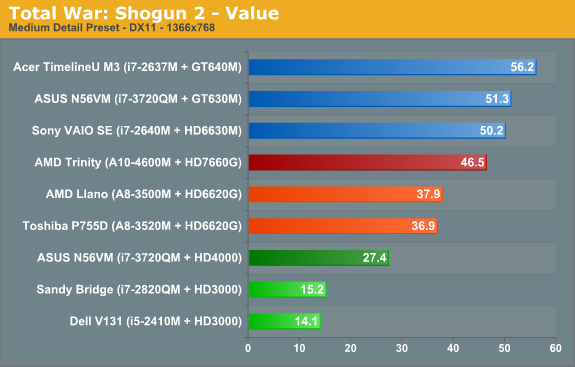
Out of our seven test titles, AMD’s Trinity leads any other IGP in four titles by a large margin. The other three titles actually have Ivy Bridge slightly ahead of Trinity, but the gaps aren’t nearly as big. Overall, the average performance across the seven games at our Value (medium) settings has AMD’s Trinity A10-4600M leading Intel’s i7-3720QM by 21%, and if we look at quad-core Sandy Bridge with HD 3000 (i7-2820QM) Trinity is 72% faster. Trinity is also around 20% faster than 35W Llano on average.
Let’s expand our gaming suite just a bit to see if things change, though. Just like we did with Ivy Bridge, we ran the eight games in our previous benchmark suite at medium detail settings. We can then compare performance across a wider 15 title selection to see how Trinity matches up against HD 4000, HD 3000, and HD 6620G (Llano). We’ll start with the bottom (HD 3000/Sandy Bridge) and move up.
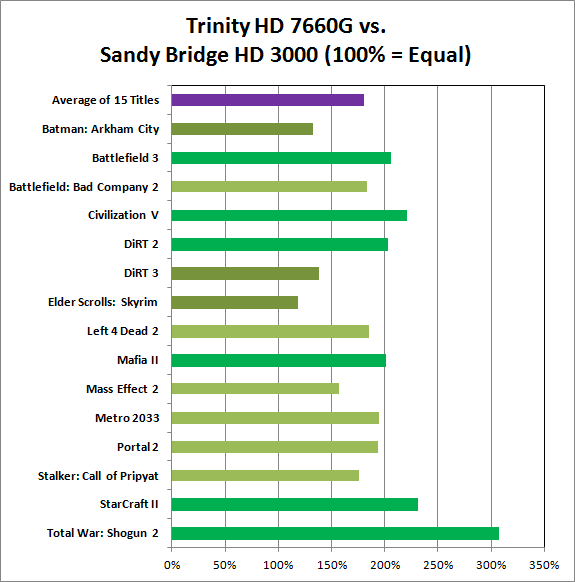
Llano’s HD 6620G was already faster than HD 3000, and Trinity’s HD 7660G is faster than Llano, so the Sandy Bridge gaming matchup is a landslide victory in AMD’s favor. The closest Intel can get is in the same three titles where Ivy Bridge leads Trinity: Batman: Arkham City, DiRT 3, and Skyrim. Here, however, HD 3000 can’t actually close the gap and HD 6620G is at least 20% faster than HD 3000, with an average performance improvement of nearly 80%.
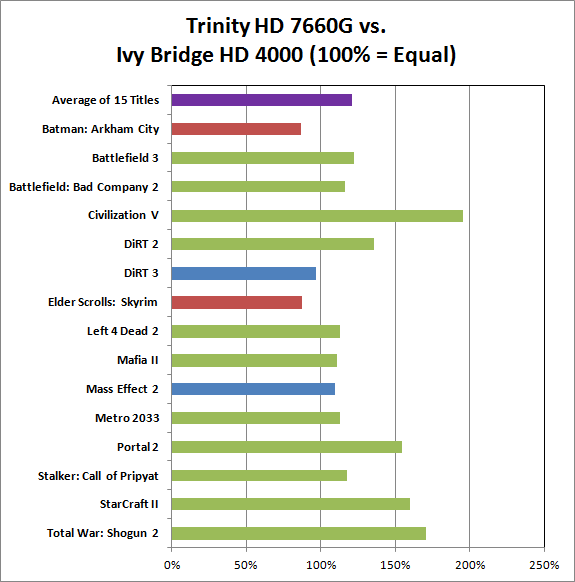
We found that across the same selection of 15 titles, Ivy Bridge and Llano actually ended up “tied”—Intel led in some games, AMD in others, but on average the two IGPs offered similar performance. This chart and the next chart will thus show a similar average increase in performance for Trinity, but the details in specific games are going to be different. Starting with Ivy Bridge and HD 4000, as with our earlier game charts we see there are some titles where Intel leads (Batman and Skyrim), a couple ties (DiRT 3 and Mass Effect 2), and the remainder of the games are faster on Trinity. Mafia II is close to our <10% “tie” range but comes in just above that mark, as do Left 4 Dead 2 and Metro 2033. The biggest gap is Civilization V, where Intel’s various IGPs have never managed good performance; Trinity is nearly twice as fast as Ivy Bridge in that title. Overall, it's a 20% lead for Trinity vs. quad-core Ivy Bridge.
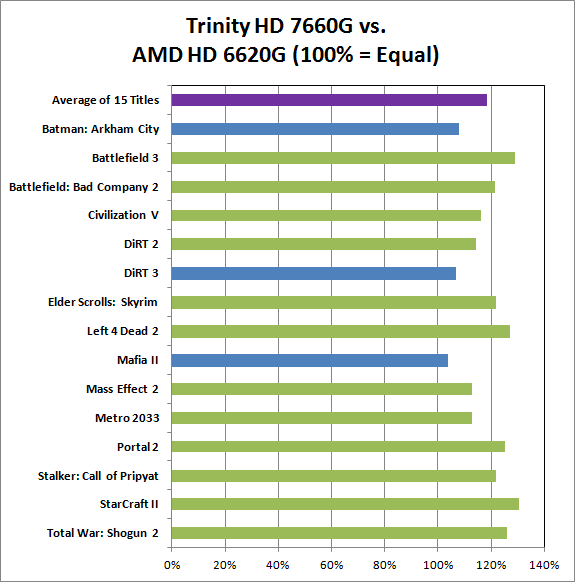
Against Llano, Trinity is universally faster, but the smallest gap is in Mafia II (3%) while the largest gap is in StarCraft II (30%). On average, looking at these games Trinity is only 18% faster than Llano. What’s not entirely clear from the above chart is whether we’re hitting CPU limitations, memory bandwidth limitations (remember that Llano and Trinity share bandwidth with the rest of the system), or perhaps both. At our chosen settings, what is clear is that Trinity’s “up to 56% faster” graphics never make it that high.
We saw 35-45% higher scores in 3DMark 11 and Vantage, which tend to remove the CPU from the equation more than actual games, so our guess would be that if AMD continues with their APU plan they’re going to need to work more on the CPU side of the equation. We also see the same thing looking at the VAIO SE scores in the earlier gaming charts: the HD 6630M scores are 20% faster on average, but much of that appears to come from the faster CPU rather than the GPU.










271 Comments
View All Comments
scope54 - Wednesday, May 16, 2012 - link
I'd like to see how much faster Piledriver is compared to a Bulldozer CPU with roughly the same specs (like an FX-4100 under-clocked to match speeds), to get an idea of what we can expect when the desktop variant releases.Arbie - Wednesday, May 16, 2012 - link
I would really have liked to have seen this! Of course none of these chips will run the game at high settings, but what will they do at lower res??? Contrary to all the nonsense printed especially on its release, Crysis was a great game even at low res AND was incredibly scalable both up and down. It remains a great yardstick for comparisions because (a) it is still challenging and (b) we have so much history with it.
Can you please at least add some average and minimum framerates, if in fact any settings were playable?
MySchizoBuddy - Thursday, May 17, 2012 - link
Is it still PCI-e 2?JarredWalton - Wednesday, May 23, 2012 - link
Yes. PCIe 3.0 is not needed for lower performance parts, and Trinity laptops aren't going to be paired with high-end GPUs I don't think. I feel like it's already hitting CPU bottlenecks in some games even with the HD 7660G!ArteTetra - Thursday, May 17, 2012 - link
"What’s Makes a Trinity?"What's this? A citation, or a kind of slang? I really don't understand the usage of two verbs (my native language is not English).
Drewdog343 - Sunday, May 20, 2012 - link
A typo =PTargon - Saturday, July 7, 2012 - link
I suspect it is a play on words. Trinity is the code name for this new generation of AMD APUs, so there has been the question about why AMD gave it this code name.silverblue - Thursday, May 17, 2012 - link
Then don't read them. Really, if you don't value what he has to say, then you're just doing yourself a disservice by adding comments.There really isn't any need to become all aggressive over your disdain for Jarred.
silverblue - Thursday, May 17, 2012 - link
If you've seen it in the article, then it's hardly "buried". He has also reiterated this point in the comments.In any case, Jarred is spot on - an SB laptop with dGPU wouldn't be much more expensive (if at all) and would perform better, however Trinity would excel in terms of power consumption. For a lot of people, its CPU performance would be more than enough, and it has easily the strongest IGP.
edge929 - Thursday, May 17, 2012 - link
WTB Trinity A10 for a new HTPC, ETA?